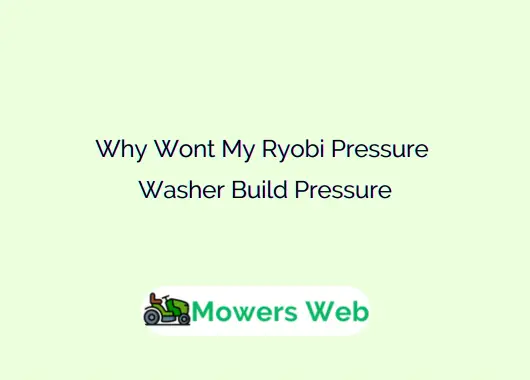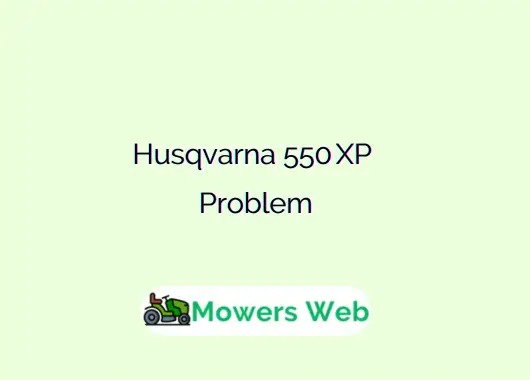If your Ryobi pressure washer won’t build pressure, it can be frustrating, especially when you’re ready to clean your driveway, patio, or car. The problem often lies in water flow, pressure components, or engine performance. Understanding the root cause will help you restore full power and extend your washer’s lifespan.
Why Wont My Ryobi Pressure Washer Build Pressure
If your Ryobi pressure washer won’t build pressure, it’s usually caused by a clogged nozzle, air trapped in the pump, insufficient water supply, or a faulty unloader valve.
Start by checking that your garden hose delivers enough water flow and that there are no kinks or leaks.
Clean or replace the nozzle if it’s blocked, and purge air from the system by running water through the hose before starting the washer. Inspect the pump for worn seals or valves, and ensure the unloader valve moves freely and is properly adjusted.
Related Ryobi Battery Comparison Chart(All Models Comparison)
Here’s step by step Fix:
1. Check Your Water Supply
The most common reason a Ryobi pressure washer loses pressure is insufficient water flow. These machines rely on a constant, unrestricted flow of water.
- Inspect the water source: Ensure your garden hose delivers at least GPM (gallons per minute) as required by your Ryobi model (usually 2–3 GPM).
- Check for hose kinks or leaks: Even a small kink or puncture can reduce pressure drastically.
- Remove any filters and clean them: Ryobi washers have inlet filters that can clog with debris, sand, or mineral buildup.
- Make sure the water is fully on: Turn the faucet all the way to ensure maximum water flow.
If your water source is weak or inconsistent, the washer pump won’t get enough supply to build adequate pressure.
2. Inspect the Nozzle
A clogged or worn nozzle is another frequent culprit. Dirt, debris, or hard-water deposits can block water from flowing freely.
- Turn off the pressure washer and disconnect the wand.
- Use a nozzle cleaning pin or paperclip to clear any debris.
- Soak the nozzle in vinegar for 10–15 minutes if there’s mineral buildup.
- Check nozzle type: Make sure you’re using the correct pressure tip. Low-pressure or soap nozzles (black) are meant for detergent application, not high pressure. Use 0°, 15°, 25°, or 40° tips for strong cleaning.
If the nozzle is damaged or excessively worn, replace it with a new Ryobi-compatible tip.
Related Ryobi Lawn Mower Comparison Chart(For All Models)
3. Remove Air from the System
Air trapped in the pump or hose can prevent pressure buildup. This commonly occurs when the washer is started without first purging air.
How to fix it:
- Turn off the washer and disconnect the spray wand.
- Keep the garden hose connected and water running.
- Squeeze the trigger on the spray gun to let water flow freely for 1–2 minutes.
- Once water runs smoothly without sputtering, reconnect everything and restart the washer.
Purging air from the system ensures the pump gets a consistent water flow and can build proper pressure.
4. Check for Pump Issues
The pressure pump is the heart of your Ryobi pressure washer. If it’s malfunctioning, you’ll get low or no pressure output.
- Pump seals or valves might be worn out: This can happen after prolonged use, especially if the unit runs dry or overheats.
- Internal debris: Dirt can enter the pump and block the internal valves, restricting flow.
- Check for oil leaks or low oil levels (gas models): Pumps need lubrication to work efficiently.
If your washer is older or used frequently, consider installing a pump rebuild kit or replacing the pump entirely. Ryobi pumps are generally easy to replace with OEM or compatible units.
Related Ryobi Battery Compatibility Chart(For All Models & Systems)
5. Inspect the Unloader Valve
The unloader valve regulates water pressure inside the pump by diverting water flow. If it’s stuck or misadjusted, the washer won’t build or maintain pressure.
- Locate the unloader valve on your Ryobi model (usually near the pump outlet).
- Remove and clean the valve: Use a small brush and mild detergent to clear any debris.
- Lubricate the spring and O-rings with silicone grease before reinstalling.
- Test the adjustment: Turn the valve screw slightly clockwise to increase pressure, but avoid overtightening.
A faulty unloader valve can cause the engine to strain or the pressure to fluctuate.
6. Check the Spray Gun and Hose
Leaks or blockages in the spray gun, wand, or hose can also cause low pressure.
- Inspect for cracks or leaks: Even small pinholes in the hose can release pressure.
- Check the trigger gun: A damaged or stuck trigger mechanism can restrict flow.
- Examine connections: Make sure all couplers and fittings are tightly secured with no air gaps.
If any part looks damaged or excessively worn, replace it. Ryobi replacement parts are widely available and affordable.
Related Ryobi Lawn Mower Height Settings Chart(For All Models)
7. Test the Engine or Motor (for Gas and Electric Models)
If you have a gas-powered Ryobi, engine performance directly affects pressure output.
- Check engine oil level and air filter.
- Inspect spark plug condition.
- Ensure the throttle is set to full speed when operating.
For electric Ryobi washers, ensure your power supply is stable and the extension cord (if used) meets the required amperage. Weak power flow can cause the motor to underperform and reduce water pressure.
8. Bypass the Soap Dispenser
If the detergent tank or soap injector is turned on, your washer might automatically switch to low-pressure mode.
- Turn the soap valve off.
- Switch to a high-pressure nozzle tip.
- Rinse the detergent system with clean water to remove clogs.
Once the soap system is fully flushed, your washer should return to normal pressure operation.
Related Where is the Serial Number on Ryobi Lawn Mower?
9. Prevent Future Pressure Problems
To avoid repeated issues with your Ryobi pressure washer:
- Always use clean water and flush the unit after each use.
- Store indoors to prevent freezing and corrosion.
- Run the washer monthly (even if not cleaning) to keep seals lubricated.
- Use a pump protector product when storing long-term, it prevents internal rust and keeps seals flexible.
Proper maintenance keeps your Ryobi pressure washer performing at full power for years.
Final words
When your Ryobi pressure washer won’t build pressure, the issue usually lies with the nozzle, water flow, air in the system, or a faulty pump component. Start with simple fixes, check your water supply, nozzle, and hose connections, before inspecting deeper issues like the pump or unloader valve. Regular cleaning, correct storage, and timely part replacement will ensure consistent performance and extend your washer’s lifespan.




